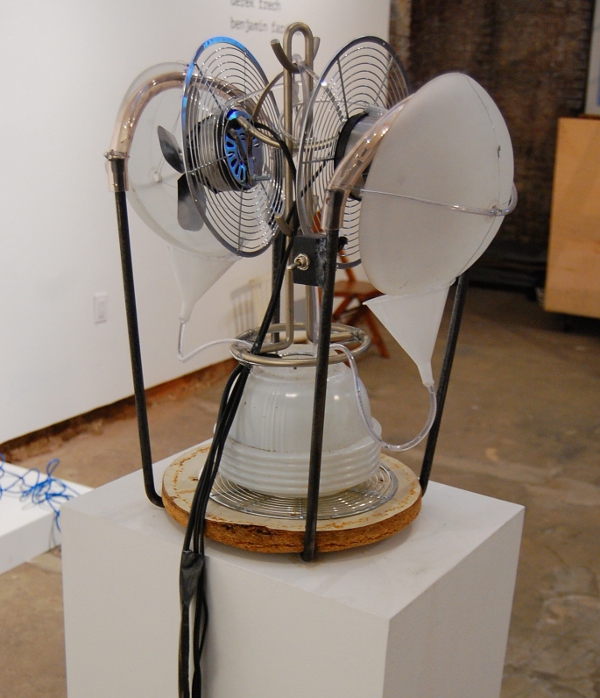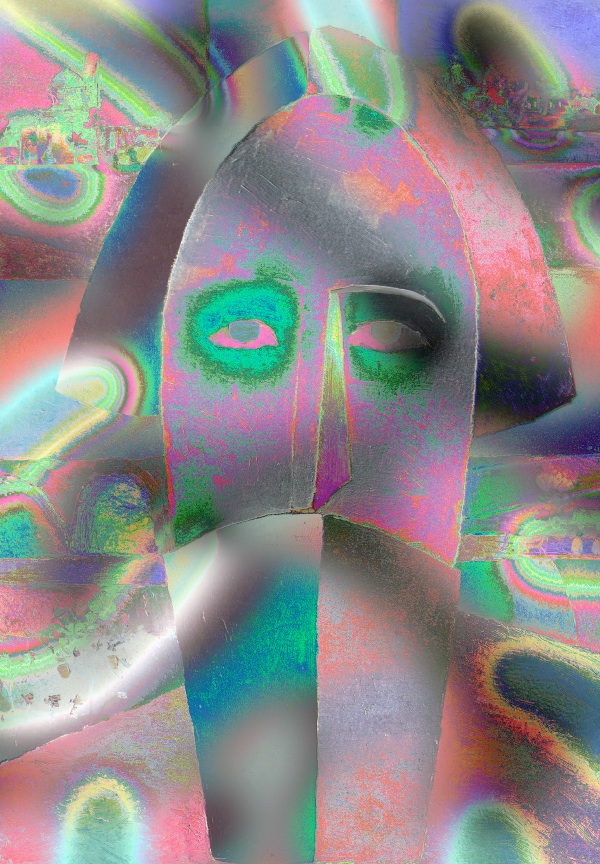
>get >put at Little Berlin conceptualizes the Internet
If you are reading this, there is no doubt that your daily activities typically include the casual uploading and downloading of content on the Internet. At Knight Arts Grantee exhibition space Little Berlin in North Philly, the show “>get >put” explores the sometimes maddeningly complex relationships between input and output, the physical and the digital, individuals, networks and aesthetics. Curated by Kelani Nichole, the show includes work by six artists who attempt harness the book “The Sound of Downloading Makes me want to Upload” as a source of inspiration.
Derek Frech confronts the divide between the online and “real” world in a not-so-subtle way. In his piece “modem/router rock, camo version,” he wires up a mundane chunk of rock into a would-be digital modem. This crossover of high-tech and no-tech does well to placate both technophiles and Luddites alike. It is, as of now, non-functional, but the artist hopes to continue the project until the rock really does send a wireless signal from its antennas. It is hard wired into the wall with a coaxial cable amidst a backdrop of trees and ferns, thus the camouflage.
Giselle Zatonyl, “the internet.”
The Internet itself is conceptualized in Giselle Zatonyl’s aptly named “the internet”. Two fans perpetually spray water, which is then recycled through tubes in a sort of mini water cycle. Clearly, the constant exchange of material is representative of the flow of information. Here, a 3D animation of the sculpture mirrors the physical construction, allowing it to exist in an ideal, digital world as well as the tangible one.
All of the artworks in this show have a dual life in the gallery and on the web. Case in point, Benjamin Farahmand’s “lo and behold I am become as a god.” This project lives mostly online through YouTube videos recorded in an on-site booth. The artist prompts visitors to read and record lines from “Flatland” by Edwin Abbot. The users’ likenesses are appropriately flattened and uploaded to a playlist which serves as an iteration of the novel in contemporary form.
Travess Smalley, “head of a peasant – kazimir malevich.”
Travess Smalley works by remixing famous works of art via digital manipulation in a sort of psychedelic art history lesson. He displays many of his neon reinterpretations in a zine wordily titled “helmet mask with praying mantis and other masterpiece reproductions I’ve scanned.” In an age where remixing songs and appropriating images is practically second nature and famous art is easily accessible with a mere Google image search, Smalley draws on these sensibilities and accessibility for a colorful, but recognizable twist with a trippy, New Aesthetic vibe.
A. Bill Miller, “gridworks_walldrawing2.”
During the opening, A. Bill Miller provided an accompanying performance for his piece “gridworks_walldrawing2,” a textual and cartographical exploration of ASCII art in vinyl. This wall art served as the surface for a live video feedback projection amidst audio samples, while the remnants of the performance continue to hang on the wall as some esoteric map of words.
Two facets make up Alexandra Gorczynski’s component of the show: mixed media physical collages with digitally animated screens and an early 90s book entitled “The Internet for Women”. The book itself is a relic full of pressed flowers. The accompanying artworks on the wall are mashups of still and moving images. One depicts a female, marble statute with monitors strategically placed across her chest and crotch. Gorczynski’s work is in many ways a feminist challenge to the notions that gender roles define one’s ability to utilize certain skill sets – specifically technology, math or science.
All in all, “>get >put” is an overloading wash of web-related content, not dissimilar from a jaunt around the fringes of the internet itself. At times (perhaps appropriately) unwieldy, like any barrage of content, the artwork is interactive and reflexive like the uploading and downloading of content it serves to mimic. There will be a closing reception on Saturday, Nov. 24 which will include a round table discussion.
Little Berlin is located at 2430 Coral Street, Philadelphia; [email protected]; littleberlin.org
Recent Content
-
Artsarticle ·
-
Artsarticle ·
-
Artsarticle ·



